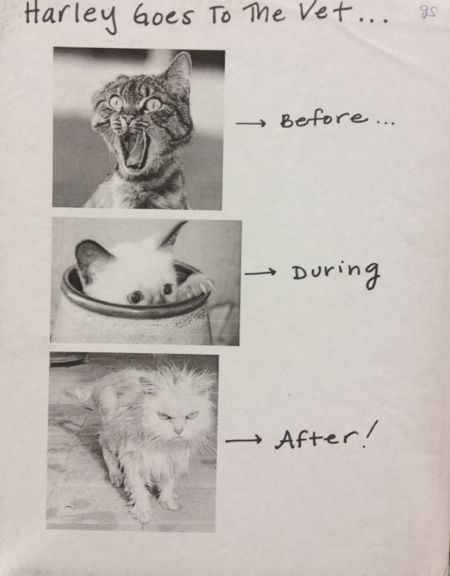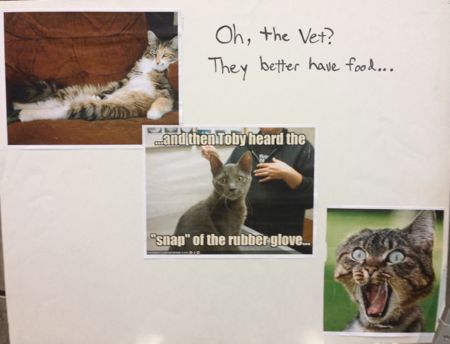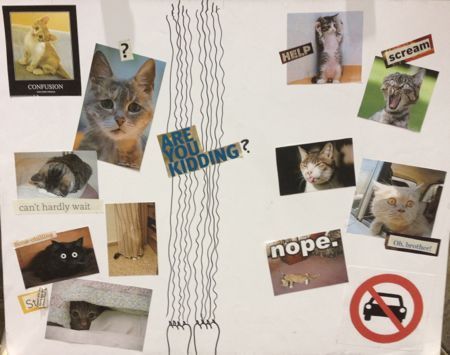How cat owners feel about veterinary visits: An illustrated guide
Bayer study offers new feline data, tips for veterinary practices and clients.
Next >

This poster was created by a cat owner who participated in the Bayer Veterinary Care Usage Study. Focus group participants were asked to create a collage illustrating what it was like to take their cat to the veterinarian. The following pages show additional posters submitted by cat owners.
Pet owners consider their dogs to be companions and their cats to be pets. This is one reason 52 percent of cats haven’t visited the veterinarian in the last year, according to the Bayer-American Association of Feline Practitioners (AAFP) Veterinary Care Usage Study presented at the American Veterinary Medical Association (AVMA) annual conference in Chicago on July 20.
What surprised John Volk, a Brakke consultant and one of the study’s investigators, is that when asked in a focus group, pet owners said they were more than willing to seek care if they thought their cat was sick. This seems like great news. However, more than half (53 percent) of owners said their cat had never been sick or injured. It also doesn’t help that when cat owners describe a trip to veterinarian, it sounds like something out of a horror flick (see poster above).
“Cats are not just small pointy eared dogs—they’re a whole different species,” Volk says. “Cat owners are a different species from dog owners as well.”
Click the "Next" button below to learn five facts you need to know from the study, get tips on how to lure cats back into your clinic, and see more collages illustrating cat owners' feelings about veterinary visits.

Fact: 83 percent of new cats are taken to the veterinarian within the first year of ownership
Make first impressions count. In this first year of ownership, cat owners are for some reason motivated to visit the veterinarian, Volk says. “However, a lot of those cats will never come back, so that's the veterinarian’s one shot,” he says. “It’s certainly an opportunity that veterinarians can leverage.”
Client tip: Brainstorm with your team and come up with a brief “elevator pitch” about why cats need annual veterinary exams. Give this spiel at the client’s very first appointment. If you don’t tell the client then, you might not have another chance.

Fact: 52 percent of cats haven’t been to the veterinarian in the past year.
Stay positive. “Cat owners who haven’t been to the clinic in a couple of years are afraid they’re going to be reprimanded,” says former American Association of Feline Practitioners (AAFP) president Elizabeth Colleran, DVM, MS, DABVP, owner of Chico Hospital for Cats in Chico, Calif. That’s why it’s important to be especially welcoming to cat owners and make their experience as enjoyable as possible.
Client tip: Send pet owners home with written care instructions and follow up with wellness care reminders. “There’s a reason why your dentist sends you home with a toothbrush and toothpaste at the end of the visit,” Colleran says.
Also explain to clients that the longer they go without visiting the veterinarian, the more traumatic it is for the cat when they do come back.

Fact: Half as many cats get annual checkups as dogs.
Be nosy. While examining a client’s dog, Colleran says this is the perfect opportunity to ask, “Do you have any other pets at home?” You may get another patient—or two—out of the deal.
Client tip: Tell pet owners they can ease cat carrier fears by lining the carrier with soft bedding and placing it near where the cat rests. Have them leave the door open and occasionally place treats inside the carrier.

Fact: 81 percent of pet owners believe cats are independent and self-sufficient, therefore requiring little attention.
Explain that cats keep secrets. Many pet owners are overconfident, Volk says—their mentality is, “I know my pet better than anyone. I’d know if she were sick.” It’s your job to explain that there are some conditions that can’t be detected without a complete physical exam or diagnostic testing.
Client tip: Tell cat owners the signs of illness and injury, such as changes in interaction, activity, sleeping habits, food and water consumption, grooming, vocalization, unexplained weight loss or gain, and so on. And make it clear sometimes cats won’t show any signs. This is why annual exams are vital to their cat’s health.

Fact: 69 percents of cats were obtained at no cost
Introduce payment options. Cats are perceived as low-cost animals, and 59 percent of them are acquired without prior intent. So is it surprising when cat owners don’t want to dish out dough for a pet (or three) that just showed up on their stoop one day? Volk says this is the time to bust out the payment options. “Wellness plans really resonate with cat owners,” he says. “They may not go for the $50-a-month option, but they'll do $20 a month.”
Client tip: Have a multi-pet discount at your clinic? Be sure to advertise this to cat owners because many times they have more than just one cat at home. Click here for more ways to make your practice cat-friendly.